The global managed services market reached $297.2 billion in 2024, which shows why post-go-live Salesforce support has become vital for organisations worldwide. A successful Salesforce implementation marks just the first step of a longer trip. The system’s go-live represents the beginning, not the final destination.
Salesforce releases updates three times every year, and your system’s optimisation needs constant attention. More companies now prefer Salesforce managed services because they provide expertise without the need to build technical support teams in-house.
This piece explains why post go-live support is a vital part of maximising your Salesforce investment. You’ll learn about common challenges organisations face after implementation and how Salesforce managed support services can solve these problems effectively.
A Deeper Look at the Salesforce Post-Go-Live Phase
The real value of Salesforce emerges after deployment, when organisations move from implementation to daily operations. Many companies think the journey ends at go-live, but that’s where it actually begins.
What Happens After Salesforce Go-Live?
Salesforce launch changes the focus from implementation to making things better. Companies see theoretical benefits turn into actual results during this adjustment period. Organisations need to pay attention to several key areas:
- System performance optimisation and monitoring
- Data quality management and clean-up
- User adoption and participation challenges
- Customisation improvements based on ground usage
- Integration improvements with other systems
- Reporting and analytics setup
Salesforce releases three updates annually with new features that can improve productivity. Further, many companies discover that Salesforce already has built-in features they aren’t using – some of which could solve problems or streamline processes. Regularly reviewing new and existing features helps uncover these hidden gems, making your operations more efficient.

Why Post-Go-Live Support is Significant for Long-Term ROI
Your return on investment depends on the post-implementation period. Adoption challenges, integration gaps, and missed opportunities can hurt your big investment in Salesforce without proper post-go-live support.
User adoption remains a big concern. Even well-laid-out systems need time and support to become part of daily workflows. Low user adoption is the primary cause of the underperformance of about 65% of CRM projects and the primary reason why Salesforce ROI stops increasing.
Post-go-live support bridges the gap between implementation and long-term success. This ensures the platform grows with your business needs while protecting your investment.

Key Challenges Faced After Go-Live
The original excitement of implementing Salesforce often fades when organisations face critical challenges. These challenges can undermine their investment if left unchecked.
Low User Adoption and Training Gaps
Research shows that up to 70% of digital transformation projects fail for many reasons, including the fact that users don’t embrace the system. Most employees use only half of their CRM’s available features. Users often resist new technology when they don’t see its benefits or find it confusing. This resistance shows up when they go back to their old tools and create inconsistent processes. Sales teams who are used to traditional methods feel overwhelmed by the new user-friendly interface. The best solution is to set up dedicated support channels with “superusers” who can boost adoption through monthly Salesforce usage reviews. One-time training sessions don’t work well – teams need ongoing support to truly embrace the system.
Licence Usage and Storage Limits
After the live phase, integration monitoring ensures that all connected systems communicate seamlessly to avoid disruptions and maintain smooth data flows. Tracking data, file, and API storage usage prevents capacity issues, keeping Salesforce running efficiently and supporting ongoing business growth. Auditing licence utilisation helps organisations manage costs by ensuring they only pay for the licenses they need and use.
Data Quality and Duplication Issues
Bad data affects decision-making and erodes user trust. Duplicate records, missing information, and outdated data waste time and push users away from the system. Data quality helps maintain accurate information, from standard formats to company-specific needs. Data profiling reveals how well current data matches these rules. Teams need validation rules, regular cleaning schedules, and duplicate prevention strategies to keep data accurate.
Security and Compliance Oversights
SaaS platform security incidents cost more and happen more often now. Common problems include poorly trained admins, missing multi-factor authentication, phishing-based account theft, and settings that expose sensitive data. Regular security audits, role-based access controls, and data encryption provide essential protection.
How Salesforce Managed Services Address These Challenges
Salesforce managed services bring specialised expertise to handle post-implementation challenges. These services will give a company the best return on its CRM investment. The solutions target specific problems that pop up after the system goes live.
Real-Time Monitoring and Performance Tuning
The service providers run proactive health checks and monitor systems around the clock to spot problems early. They track API usage, find performance bottlenecks, and fix security issues without disrupting work. Teams can focus on selling while the providers keep an eye on system performance.
User Support and Training via Managed Services
Poor adoption often happens because of weak training and support. Service providers fix this with dedicated helpdesk systems, quick troubleshooting, and regular training sessions. They set up easy feedback channels to spot improvement areas that ended up boosting self-serve success and platform stickiness.
In the post-implementation phase of Salesforce, training is provided to a wide range of users across the organisation. This applies to both non-technical and technical staff:
- End users such as sales representatives, customer service agents, marketing team members, and others who use Salesforce in their daily work. Training is tailored to each role’s specific needs and tasks to ensure effective adoption and integration into daily workflows.
- Managers and executives receive training focused on reporting, dashboards, and collaboration features so they can monitor performance and support their teams.
- Salesforce administrators and developers are trained in system configuration, user management, and ongoing maintenance to keep Salesforce optimised and secure.
A responsive help desk fixes problems for users and answers questions about how to use or understand Salesforce features or processes. It should have clear SLAs for response times and be accessible through a variety of channels. This minimises downtime and prevents small issues from becoming major barriers to adoption.
Data Clean-up and Deduplication Strategies
Data quality issues like duplicate records and broken workflows can grow into big headaches in unmanaged Salesforce systems. Service providers run systematic data audits, remove duplicates, and enhance data quality. These regular checks keep reports reliable and turn potential problems into trusted, accurate information.
Security Audits and Access Control Reviews
The services include complete security measures like vulnerability checks, data encryption, multi-factor authentication, and threat monitoring. Regular access control checks help follow the least privilege rule and reduce security risks.
Release Management for Salesforce Seasonal Updates
Salesforce’s updates need expert handling to test changes without disrupting work. Service providers manage seasonal updates by testing them in dedicated environments. They use a variety of specialised tools (Gearset, Copado, Flosum, and Blue Canvas) to automate and orchestrate deployments. This careful approach helps make necessary changes smoothly and keeps the business running during upgrades.
Automation and Data Flow through Integrations
Exploring and delivering integration opportunities means connecting Salesforce with other business tools (such as email, ERP, or marketing automation platforms). Managed services evaluate needs and implement integrations, enabling seamless data flow and process automation. AppExchange’s marketplace offers powerful integration capabilities through compatible applications. This boosts productivity and ensures Salesforce becomes a central, unified platform.
Proactive Growth and Continuous Improvement
Managed services support continuous improvement by iterating on system design, workflows, and user training. They track industry trends and Salesforce releases to recommend new features or approaches, helping the organisation stay ahead of competitors and shifting business demands.

Best Practices for Post-Go-Live Managed Services
Organisations need several key practices to maximise their Salesforce platform’s value after the original deployment. Companies that succeed after implementation use well-laid-out approaches to promote continuous improvement and scalability.
Setting Up a Dedicated Support Channel
A designated support desk within Salesforce creates an efficient communication pathway for users who face challenges. Users and administrators both benefit from this dedicated channel. Users get transparent case tracking and centralised resources. Administrators can better manage and prioritise consolidated requests. An effective support channel has:
- A centralised hub with quick links to essential resources
- Self-help knowledge articles for common questions
- Efficient case submission forms with proper categorisation
Creating a Feedback Loop for Continuous Improvement
A systematic approach to user feedback drives ongoing platform refinement. Teams should regularly collect user feedback using surveys, meetings or built-in apps to understand what is working well and where there are challenges. This process helps teams identify optimisation opportunities and expand adoption over time.
Service providers show they’re committed to supporting your team and keeping Salesforce closely aligned with your business needs. This ongoing dialogue helps to improve the system and deliver better results over time.
Customising Salesforce with Scalability in Mind
Smart customisation balances current needs with future growth potential. Teams must assess solutions against evolving business requirements regularly. This work involves monitoring performance metrics, optimising data storage, and creating custom objects only when needed. Detailed documentation of all customisations helps future maintenance and troubleshooting.
Establishing Governance with Service Level Agreements
Service level agreements (SLAs) set clear performance standards between service providers and customers. These contracts define service quality expectations, availability, and response times. Well-structured SLAs create accountability through automated alerts for potential breaches, which enables quick intervention. SLAs boost customer satisfaction by guaranteeing consistent service quality throughout the post-deployment experience.

Beyond Go-Live: The Power of Managed Services in Salesforce Success
Salesforce implementation marks the start of an organisation’s CRM trip. Organisations don’t realise how complex it is to keep Salesforce running smoothly when platform updates happen, business needs change, and users might resist the system.
Managed services help tackle post-implementation challenges through immediate monitoring, user support, and data management. They also provide complete security measures and smooth update handling. Teams get expert help without spending too much time and money building their own capabilities.
The shift from implementation to optimisation decides if Salesforce becomes a game-changing asset or just another unused tool. The go-live phase only opens new possibilities. Organisations need managed services to nurture these opportunities. Salesforce shows its true value over time through refined usage, expanded features, and smart changes that line up with company growth.
Case Study
Virtana: Salesforce Managed Services
Managing day-to-day Salesforce operations


